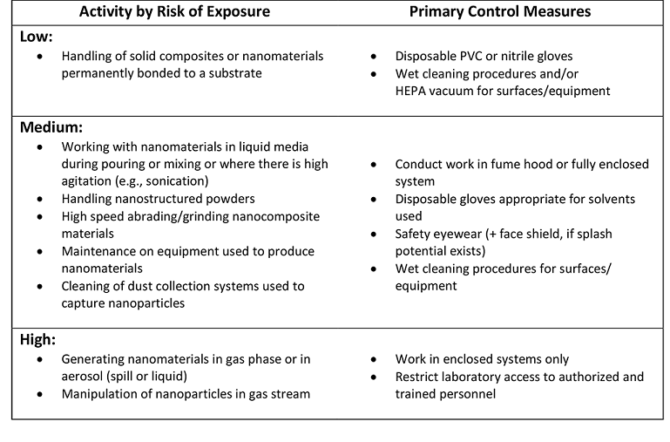Engineered nanomaterials are defined as man-made (or manufactured) materials having particles or constituents of nanoscale dimensions (usually 1 to 100 nanometers). Some nanoparticles occur in nature or as combustion products in the air, such as diesel particulates, and fine dust. Engineered nanomaterials can be found in many consumer items, such as self-cleaning windows, tennis rackets, bacteria-free socks, etc. Particles created at the nanoscale have different chemical and physical properties than larger particles of the same material. Due to their smaller dimensions, larger surface area, and potential ability to penetrate cells more easily than larger particles, free particles in the nanometer size range are being evaluated for toxicity. It can be assumed, though, that the nano-sized material is, at least as hazardous as its macro-sized material.
To mitigate the risks associated with nanomaterials, researchers should educate themselves on the characteristics and potential hazards associated with the nanomaterial they intend to use in their research and conduct a thorough risk assessment to develop a standard operation procedure for use of the material in the laboratory.
|Collapse All
Risks Associated with Nanomaterial Research
The potential health effects associated with exposure to nanomaterials used in research are not yet fully understood. The toxicity of engineered nanoparticles depends on the physical and chemical properties of the material, and it is important to note that engineered nanomaterials may have chemical and physical properties that differ significantly from the same material in bulk form. Any assessment of the hazards and risk associated with nanomaterials should include:
- an evaluation of the potential for exposure to the type of work to be done,
- an assessment of the potential for exposure to occur to the worker as well as the potential for release to the environment,
- a characterization of the risk of exposure including incidence and severity of adverse effects likely to occur in workers or the environment,
and controls to prevent exposure and minimize hazards.
Principal Investigators should use the following table to determine their risk of exposure and control measures for common lab nanotech operations (credit Stanford University).
Safe Work Practices for Nanomaterials
Use the following hygiene and general laboratory safety practices while working with nanomaterials.
- do not eat or drink in the laboratory,
- wash hands regularly,
- remove all gloves and arm sleeves, if used, before leaving the laboratory,
- clean the work area regularly with a HEPA-vacuum and/or wet wipe,
- and avoid working alone in the laboratory.
Review the OSHA Fact Sheet: Working Safely with Nanomaterials for more information about safe work practices with nanomaterials.
Labeling and Storage
Labels should indicate the presence of nanomaterials (such as the use of the term “nano” in descriptor) and any other chemicals. All nanomaterials must be stored in properly labeled containers with tight fitting screw top lids and segregated from all incompatible chemicals. Any known hazard warnings must also be identified on the container and storage areas.
Transportation and Disposal
When transporting nanomaterials, the containers should be placed inside a shatter-proof sealed container to prevent releases or exposures in the event of a spill. Prominently label any known hazardous materials. All nanomaterial waste will be collected by EHS, upon notification by the PI. Nanomaterial waste must be stored in a sealed waste container with a completed hazardous waste label to identify all hazards present.
Spills and Accidental Release
In the event of a minor spill involving nanomaterials, trained laboratory personnel may respond and address it following the standard operating procedure developed by the PI based upon the risks for work with that material. When responding to a minor spill, always use proper PPE and know the location and proper use of emergency equipment, including safety showers and fire extinguishers as many nanomaterials can be highly reactive in the presence of air or sparks, resulting in fires or explosions. In the event of a major spill, evacuate all personnel from the laboratory and call EHS, 3-8448, or 911 to report the spill.


